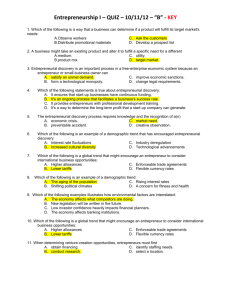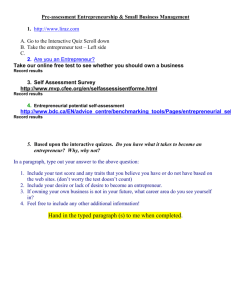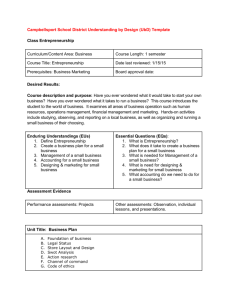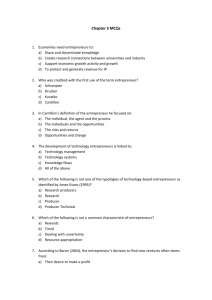Starting an IT Company - University of Missouri
advertisement
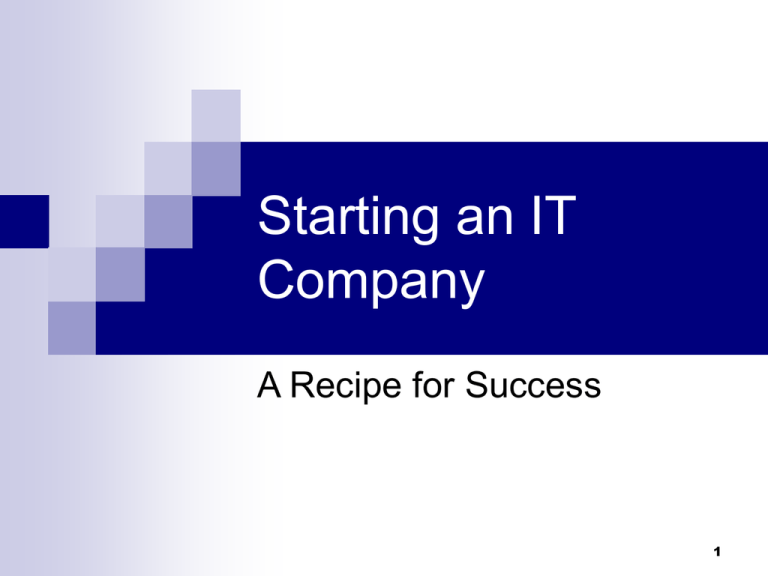
Starting an IT Company A Recipe for Success 1 Agenda Introduction Case Studies Sense Corp Qore Business Group WAN Technologies/Digital Skyway eBay Secondary Research Conclusions 2 Types of IT Startups Software Hardware Outsourcing xSP’s Internet Services Etc. 3 Set the Stage Only 30 percent of business start-ups survive more than five years. Recent increase in VC Money for technology, but it is being concentrated in a few sectors. (Wireless networking, security software, storage) Number of Start-Up companies over time: 48 1998 - 68,312 1997 - 54,239 1996 - 49,710 1995 - 23,942 1994 - 27,212 TOTALS - 223,415 47 Estimated that three out of four online start-ups will go “belly-up” in the next three years. (4/2000) 49 4 What is an Entrepreneur? Main Entry: en·tre·pre·neur Pronunciation: "änn-tr&-p(r)&-'n&r, -'n(y)ur Function: noun Etymology: French, from Old French, from entreprendre to undertake -- more at ENTERPRISE Date: 1852 : one who organizes, manages, and assumes the risks of a business or enterprise 43 5 What is an Entrepreneur? “…the idea of overcoming resistance to change, getting things done and thereby profiting. Entrepreneurial activity is contingent and situational. Entrepreneurs spot business opportunities and then commit time and resources to the pursuit of those opportunities. They do so as they weigh the incremental value of successive evolutions. And entrepreneurs, therefore, earn economic rents, for they bring together factors and resources to accomplish specific projects. They organize.”6 6 What makes a successful entrepreneur? Leadership Qualities? Management Traits? Venture Capital Availability? Timing? Technology? Location? Human Capital? Luck? Risk Taker? 7 Norman Schwartzkopf "Leadership is a potent combination of strategy and character," he says. "But if you must be without one, be without strategy." 50 8 Peter Siegel—Sense Corp 9 Siegel’s Personality Motivated Decisive Not authoritative Trusting Optimistic Hard-working Detail-oriented 38 10 Siegel’s Background Childhood traits Hyperactive, social, mischievous, self-motivated B+/A- student in high school Graduated from Syracuse University with a business degree (Logistics Management) Father is a nuclear medicine doctor Mother is a doctor’s office manager Peter did not pursue a career in the medical field like his father because he didn’t want to work as many hours as him. With his company, he now works just as many, if not more hours than his father ever worked! 11 Sense Corp IT Consulting firm specializing in Data Warehousing and Business Intelligence Peter Siegel, 31, was one of 4 founders 12 Sense Corp Profile 45 – 50 employees ~$10 million annual revenues ~100% annual growth rate from 1997 through early 2001 0% growth from mid 2001 through mid 2003 New growth has begun in the last few months 13 Sense Corp History Started in 1996 with 4 people 2 Andersen Consulting employees 1 Mallinkrodt employee (client of Andersen) 1 independent contractor (friend of Andersen consultant) working at Shell Services International current technical lead on my project First main client was Shell in Houston Grew to 10 consultants just at Shell Had a sizeable team at Enron during their fall…first consulting firm to be asked back when SEC demanded financial data 14 Sense Corp’s Success Factors Each founding partner excelled in a different area Peter -> back office capabilities Keat -> vision, business development, recruiting Brian -> execution of the vision Mike -> technical expert Run the company conservatively Didn’t want a debt situation Conservative growth approach saved them during the economic downturn Small size gives them flexibility that their larger competitors (big 5) can not duplicate Can turn around proposals within days rather than weeks Concentrate on quality of consultants rather than number of consultants 15 Recruiting Strategy Unsuccessfully worked with a head-hunter in 1999 and 2000 Occasionally uses HotJobs website to find qualified applicants Found that they cost more than they are worth Large time commitment to browse through hundreds of resumes and usually only come away with a couple potential applicants Most employees are a result of referrals from existing employees Recruiting statement: “Looking for smart, good communicators, business-minded folks with an affinity for technology” 16 Strategy for Acquiring Customers Relationships with past and existing clients Partnerships with software vendors: Business Objects Cognos Ascential Ambeo Embarcadero Growing accounts at existing clients: Charter Tyco Healthcare Enron ERCOT Bayer CropScience BCBS of Michigan Accident Fund Plains All American 17 Mark Peterson—QORE Business Solutions 18 Peterson’s Personality Expressive/Driver Flexible Stubborn Determined Caring Responsible Moral code Leader Entrepreneurial 36 19 Peterson’s Background Exposed to Entrepreneurial Leadership as a child US Navy DEC 20 Back to the Beginnings "Creation of processes and products, of ideas and industries, depends on people more than money, on imagination as well as initiative. Seek out creative people with the vision of things to be done. Help breathe life into new ideas and processes and products with capital - and with more than capital - with sensitive appreciation for creative drive, with support in management and manpower, with loyalty to the idea and to its initiator, the creative individual." Georges F. Doriot, President, American Research and Development (1946-1972) “Success is probably the worst problem for an entrepreneur.” 34 Ken Olsen – Digital Equipment Corporation 21 Next Steps in Peterson’s Career QORE Business Solutions Sentry Meta Group Consulting Coeur Business Group Coeur/EVP 22 QORE Business Solutions 40 employees ~$10 million annual revenues Systems Integrator, Help Desk Outsource and Cost Containment Consulting 2003 focus on Healthcare as a primary vertical 44 23 QORE Business Solutions’ Success Factors Low Risk Self Funded Partners Monsanto as key first customer Established expertise in energy market that had a gap in expertise Good Timing—Cost Reduction and Value Sourcing were a growing need. 24 Tim Johnson—WAN Technologies/Digital Skyway 25 Johnson’s Personality Good work ethic Drive Genuine concern for other people— empathy Decisive Ability to relate to others 37 26 Johnson’s Background Entrepreneurial Family AT&T WANTEC Digital Skyway 27 WAN Technologies 100 employees ~$20 million annual revenues Wide Area Network Value Added Reseller Cisco Gold Partner Network Management Outsourcing, IP Telephony and Security are key focus areas 45 28 WAN Technologies’ Success Factors Gap in telecommunications offering for CPE integration and management Self funded Balanced Partnership—Vision, Operations, Sales Initial Customers through AT&T and MCI contacts Qwest became key customer 29 Digital Skyway 20 employees ~$10 million projected sales for 2004 WiFi (Wireless Broadband) Infrastructure provider Target Markets Small/Rural market Hotel Industry Franchising 46 30 Digital Skyway’s Success Factors Gap in high speed offering to rural areas Key partnership with Primary Network Self funded Partners in Sales and Operations First to Market Franchising Model Extensive Planning “Somebody should be aware…where are the first 12 months capital coming from?” 31 Comparison of WANTEC and Digital Skyway IT viewed as a commodity today Overcoming barriers to success ahead of time is crucial to eventual success Seek existing commodities of scale—become part of an ecosystem rather than creating it yourself Find good business partners 32 Pierre Omidyar “If you come from a democratic, libertarian point of view, having a corporation just cram more and more products down your throat doesn’t seem like a lot of fun. “I wanted to do something different, to give the individual the power to be a producer as well as a consumer.” 16 33 Company Profile eBay Inc. operates a marketplace in which anyone, anywhere, can buy or sell practically anything. The Company has developed a Web-based marketplace in which a community of buyers and sellers are brought together to browse, buy and sell various items. Feedback System – Users provide rating for other users. PayPal service - eBay enables any business or consumer with e-mail to send and receive online payments securely, conveniently and costeffectively.24 34 Pierre Omidyar Born: 1967, Paris (only child) Parents from Iran migrated to France and then US Father M.D. at Johns Hopkins Mother, Linguist First IT Project at 14; Computerized school library catalog Attended Tufts University in mid-80’s 17 35 Omidyar (Cont) Finished undergraduate at UC-Berkeley Internship at Innovative Data Design First paying job at Claris 1991- Founded startup Ink Development Ink Development re-launched as eShop 1994 – Left eShop (but retained equity stake) 1996 – Microsoft buys eShop. Millionaire before 30 Joined developer relations at General Magic 18 36 Creation of AuctionWeb Legend PEZ Story Reality Pierre spends summer of ’95 obsessing about internet Pierre got in on 3DO IPO and found inequality & inefficiency in market Sought to create online community with level playing field 19 PEZ angle used to get press coverage early on 20 37 AuctionWeb in Action Labor Day Weekend, 1995 – Developed AuctionWeb.com Initially one of 3 pages on Pierre’s personal homepage AuctionWeb was a hobby. Echo Bay Technology Group – Pierre’s sole proprietorship for web consulting Broken Laser Pointer example 21 Free service until personal ISP become Commerical Account due to traffic Arbitrarily Charged 5% for items under $25; 2.5% for items over $25. Checks started to appear June, 1996 Exceeds Gross Revenue of $10,000 in a month Quits General Magic to work on AuctionWeb 22 38 Enter: Jeff Skoll February, ‘96 – Consulting for AuctionWeb August, ’96 – “Co-Founder” Stanford MBA Born in Toronto, Canada Had job selling Amway door-to-door at 12 Hired by Knight-Ridder for internet strategy Brought business practices to Pierre’s hobby 23 39 AuctionWeb to June, 1997 - $5 Million in Venture Capital Funding for 21% stake September, 1997 – Overdue upgrade to site and re-branded as eBay Missed Opportunity for Patenting 24 January 1998 42 Exceeds 21 million bids total bids; daily average of 120,000 5 million auctions since 1995; daily average of 200,000 per day 40 User Statistics 40 70 60 (Millions) Registered Users 80 50 40 30 20 10 0 '97 '98 '99 '00 '01 '02 Year 41 Financials – Stock Price 41 42 Stock Price vs Nasdaq 41 43 20 04 20 04 20 03 20 03 Q 4 Q 2 Q 4 Q 2 Q 4 Q 2 Q 4 Q 2 Q 4 Q 2 Q 4 Q 2 Q 4 EPS 20 02 20 02 20 01 20 01 20 00 20 00 19 99 19 99 19 98 EPS eBay Financials 41 Estimates 0.35 0.3 0.25 0.2 0.15 0.1 0.05 0 44 5 Yr Income Statement 41 Year 1998 1999 2000 2001 2002 Revenue $ 86 $ 225 $ 431 $ 749 $ 1,214 Gross Profit $ 70 $ 167 $ 336 $ 614 $ 1,000 Gross Profit Margin 81% 74% 77% 81% 82% Net Income $7 $ 10 $ 48 $ 90 $ 250 Net Profit Margin 8% 4% 11% 12% 20% 45 Success Factors Created a Community Efficiency Golden Rule in Cyberspace – Feedback ratings No Inventory = Little Cost/Risk 80% Profit Margins in early years Profitable from 1st month of operations Personal Involvement of with “community” Word of Mouth Discussion Boards Public email addresses for principals Self-funded until established – very thrifty “Great eBay Flood” 46 “Productive people know there is always a choice: a choice to succeed, an option for happiness, a decision to see the unexpected as a challenge, not a crisis.” 31 47 What makes a successful entrepreneur? Leadership Qualities? Management Traits? Venture Capital Availability? Timing? Technology? Location? Human Capital? Luck? Risk Taker? 48 Leadership “What helps a founder – often the person who developed a new technology application, which can be solitary work – succeed as CEO? Leadership [... and the…] Ability to resolve conflicts.” “[In a non-scientific sample of 200 companies] fewer than 40% of founder-CEOs made it past second round of venture financing” “It’s abnormal to have the guy from Day One who has the capacity to grow and morph” 14 49 Management Traits 7 Entrepreneurial Managerial Behaviors Managing Culture Managing Vision Entrepreneurial Global Competence Space Generic Managerial Behaviors Managing Process Managing Stakeholders and Environments Managing Development Nonentrepreneurial Managerial Behaviors Managing Performance Nonentrepreneurial 50 Venture Capital Investment 3 Types Description Early Stage Funding Average of Total 49.7% - Seed Prove a concept 3.4% - Startup Product development / initial marketing 8.4% - Expansion Initial expansion of established company Late Stage Funding 37.9% 50.3% 51 VC Investment Trend 39 120.00 (Billions) Amount 100.00 80.00 60.00 40.00 20.00 0.00 '90 '91 '92 Inv Amt (B) 2.90 2.30 3.60 '93 '94 '95 '96 '97 '98 '99 '00 '01 '02 3.90 4.20 7.70 11.60 15.20 21.50 55.00 106.4 41.10 21.20 Number 1471 1279 1415 1209 1239 1901 2656 3250 4203 5684 8208 4691 3028 Avg (M) 1.95 1.79 2.54 3.2 3.39 4.04 4.36 4.66 5.11 9.68 12.96 8.76 6.99 52 Timing Time is a major factor in whether or not start-ups are successful… “There is some indication that the survival of small firms is affected by overall economic conditions when they first entered into business.” 4 “The difference between success and failure of a startup is often a matter of timing, liking selling one's dot.com shares before the market crashed.” 33 53 “Good ideas are common; the people who can implement them are rare.” 31 54 Human Capital 3 Important Findings 8 Entrepreneurs with more Human Capital perform better but do not necessarily survive more frequently Entrepreneurial skills specific to the venture…customer, supplier, product and services…are directly related to performance and survival Survival directly related to age, family experience, or motivation driving higher levels of persistence, resulting in survival 55 Human Capital & Social Interaction 1 56 Luck “…Business is not a completely rational process. There are always factors beyond your control--some that you're aware of, some that will hit you out of the blue. Luck determines whether you succeed despite those wild cards, and you can never completely eliminate it as a factor, but you can reduce its importance…” 35 57 Passion In order to succeed as an entrepreneur, you must have passion in what you are doing. Entrepreneurs tend to work long hours. Entrepreneurs do not often find immediate success. “Business ventures required sacrifices of salaries or security, willingly made because the companies were based on dreams and passion for technology.” 25 58 Planning “The significant relationship between pre-startup activity and expansion intentions is consistent with the findings of Van Auken and Neeley (2000). They suggested that the preparation of prestartup documentation (e.g. business plans, cash flow projections) lead to a more efficient capital structure. “ 5 “Engaging in tangible activities - signing a lease, applying for a patent, conducting a market study - prior to the registration of the business, the owner-manager effectively builds self-confidence which, in turn, helps to cultivate growth aspirations.” 5 “Successful entrepreneurs also have imagination, the ability to envision alternative scenarios. I think of it as always having a Plan B.” 31 59 Marketing Many new entrepreneurs think success is all about developing a great product or service, but actually it's all about selling it. 51 Marketing is by far the biggest problem faced by small businesses. 4 60 Marketing “Companies ought to establish early and frequent contacts with prospective customers to clarify understanding of customer needs and to reflect these needs in product attributes.” “Entrepreneurial teams should include at least one founder with a strong background in sales or marketing, who will inevitably provide different information and attitudes from often-dominant technical cofounders.” Firms with dedicated marketing personnel have a higher degree of success. 2 61 IT Skills Do Not Make the IT Entrepreneur “Skills, which are most lacking, are often not technical or technological. Rather, we find that most entrepreneurs lack good marketing, financial and organizational skills.” 4 “Business performance had a negative correlation with the firm's relative dependence on the technical skills of the owner-manager.” 5 62 What makes a successful entrepreneur? Research Shows Location Leadership Qualities Management Traits Human Capital Luck Timing Venture Capital Availability Technology Risk Taker Passion Planning Marketing 63 Success Factors •Pre-Founding •At Founding •Post Founding •Corporate Success 2 64 Compare Case Studies to Research Peter Siegel Mark Peterson Tim Johnson Leadership Qualities X X X Management Traits X X X Timing X X X X Human Capital X X X X Luck X X X X Passion X X X X Planning X X X Marketing X Pierre Omidyar X *A strong correlation exists between important entrepreneurial traits identified by research and those displayed by the successful entrepreneurs in our case studies. 65 Advice to Would-Be Entrepreneurs Have Industry Knowledge Be Willing to Work Long, Hard Hours Get Expert Help—Banker, Lawyer, Accountant, etc. Research for Demand Keep Good Records Have Adequate Starting Capital Be Prepared to turn over the reigns, if successful 10 66 Advice to Would-Be Entrepreneurs Develop a Business Plan Set Goals: sales, profits, market share, etc. Hire good employees Watch Overhead and Fixed Costs Continue your Education Use Employee Participation Diversify your Product 10 67 Recipe for Success Having a blend of these critical ingredients does not guarantee success. However, they will increase the likelihood of success for your information technology startup. 68 Bibliography 1. 2. 3. 4. 5. 6. Lechler, Thomas. “Social Interaction: A Determinant of Entrepreneurial Team Venture Success”, Small Business Economics. Vol. 16 (2001); pp 263-268. Roberts, Edward B. "The Success of High-Technology Firms: Early Technological and Marketing Influences.“ Interfaces. Vol. 22, Iss. 4 (July/August, 1992); pp. 3 – 12. Rausch, Lawrence M. “Venture Capital Investment Trends in the United States and Europe”, National Science Foundation. NSF 99303; October 16, 1998; pp 1 – 4. Wu, Chunchi and Young, Allan, “Critical operating problems and survival rates in small firms: A look at small business institute clients”, Journal of Developmental Entrepreneurship, Apr 2002. Vol. 7, Iss. 1; pg. 1, 23 pgs LeBrasseur, Rolland, Zanibbi, Louis, and Zinger, Terrence J, “Growth Momentum in the Early Stages of Small Business Start-ups” International Small Business Journal, Vol. 21, Iss. 3, 8/2003, p 315 Osborne, Alfred E., Jr., Understanding Entrepreneurship, Business Forum; Fall 1987; 12,4; ABI/INFORM Global, pg. 12 (what is an entrepreneur) 69 Bibliography 7. 8. 9. 10. 11. 12. Sadler-Smith, Eugene; Hampson, Yve; Chaston, Ian; Badger, Beryl; Managerial behavior, entrepreneurial style, and small firm performance; Journal of Small Business Management; Jan 2003; 41,1; ABI/INFORM Global pg 47 Gimeno, Javier; Folta, Timothy B.; Cooper, Arnold C.; Woo, Carolyn Y.; Survival of the fittest? Entrepreneurial Human Capital and the Persistence of Underperforming Firms, Administrative Science Quarterly; Dec 1997; 42,4; ABI/INFORM Global, pg 750 Lussier, Robert N.; Startup business advice from business owners to would-be entrepreneurs; S.A.M. Advanced Management Journal; Winter 1995; 60,1; ABI/INFORM Global pg 10 Keely, Robert H., Roure, Juan B.; Management, Strategy, and Industry Structure as Influences on the Success of New Firms: A Structural Model; Management Science; Oct 1990; 36, 10; ABI/INFORM Global; pg 1256 (management traitsI Amit, Raphael; Glosten, Lawrence; Muller, Eitan; Does Venture Capital Foster the Most Promising Entrepreneurial Firms?; California Management Review; Spring 1990; 32, 3; ABI/INFORM Global; pg.70 102 Bibliography 13. 14. 15. 16. 17. 18. 19. 20. 21. Anonymous. “What they need to succeed.” Canadian Banker. Toronto: Jul/Aug 1995. Vol. 102, Iss. 4; pp 24 – 25. Bailey, Jeff. “Small Business – Entreprise: For Investors, Founders Are Short-Term CEOs.” Wall Street Journal. (Eastern edition). New York, NY: Oct 21, 2003; pg A.24. Banks, Brian. “The silicon billionaire.” Canadian Business. Toronto: Jul 30-Aug13, 1999. Vol.72, Iss. 12; pp 26-31. Cohen, Adam. The Perfect Store: Inside eBay. New York: Little, Brown and Company, June 2002; pg 7 Ibid, pp 15-16 Ibid, pp 17-21 Ibid, pp 18 Ibid, pp 83-84 Ibid, pp 4-5 71 Bibliography 22. 23. 24. 25. 26. 27. 28. 29. Ibid, pp 21-30 Ibid, pp 30-72 Ibid, pp 76-91 Colkin, Eileen. “Blast from the past.” InformationWeek. Manhasset: May 7, 2001. Iss. 836; pg 89 – 92. Faletra, Robert. “Now may be the best time in a decade to become a solution provider.” CRN. Jericho: Sep 22, 2003. Iss. 1063; pp 82. Grimes, Ann. “Venture Capitalists: a Bit More Willing.” Wall Street Journal (Eastern edition). New York, NY: Jul 29, 2003; pg C1. Krekhovetsky, Luba. "75th Anniversary: Jeff Skoll." Canadian Business. Toronto: Feb 3, 2003. Vol. 76, Iss. 2; pg 54-56. Skoll, Jeff. “New town square.” Forbes. New York: Oct 4, 1999. pg 65 – 67. 72 Bibliography 30. 31. 32. 33. 34. 35. 36. 37. 38. Phillips, Bruce D., Headd, Brian. “Characteristics of Small Business Employees and Owners.” U.S. Small Business Administration’s Office of Advocacy, Office of Economic Research. 1998. Goodman, Jon P., “What Make an Entrepreneur”, Inc, 10/1994, p. 29 Himelstein, Linda, “All Cashed Up with No Place to Go”, Business Week, 9/29/2003, p. 107 Davidson, Andrew, “Rupert Howell’s 10 Steps to Start-up”, Management Today, 4/2003, pp. 58-62 Rifkin, Glenn and Harrar, George; The Ultimate Entrepreneur; 1988; Contemporary Books, Inc. (Ken Olson) Brodsky, Norm; Improving Your Luck; Inc. Magazine, Apr 1997 Mark Peterson, CEO Coeur Business Group, interviewed in person by Tim Myers, October 10, 2003 Tim Johnson, CEO Digital Skyway, interviewed in person by Tim Myers, October 12, 2003 Peter Siegel, CFO of Sense Corp, interviewed in person by Micah Katcher, October 3, 2003. 73 Bibliography 39. http://www.nvca.org/ffax.html, viewed 10.16.2003 (National Venture Capital Association) 40. http://investor.ebay.com/annual.cfm, viewed 10.17.2003 (eBay Annual Reports) 41. http://bigcharts.marketwatch.com/, viewed 10.30.2003 42. http://pages.ebay.com/community/aboutebay/releasespr 98.html, viewed October 17, 2003 43. http://www.webster.com/cgi-bin/dictionary, viewed 10.18.2003 (entrepreneur definition) 44. http://www.qorebusiness.com/about_why_qore.cfm viewed 10.19.2003 74 Bibliography 45. 46. 47. 48. 49. 50. 51. http://www.wantec.com/about/index.htm viewed 10.19.2003 http://www.digitalskyway.com/company.shtml view 10.19.2003 http://www.venturecoach.com/resources/content_stats.htm, viewed on 10.15.2003 http://www.score.org/entrepreneurship_career.html , viewed on 10.15.2003 http://www.drapkin.net/news/whystartupsfail.html , viewed on 10.15.2003 http://www.brainyquote.com/quotes/quotes/g/genhnorma124399.ht ml, viewed on 10.15.2003 http://www.entrepreneur.com/article/0,4621,304960,00.html viewed 10.28.2003 75

